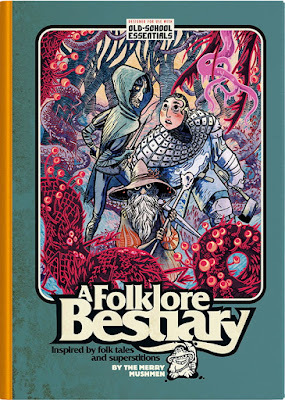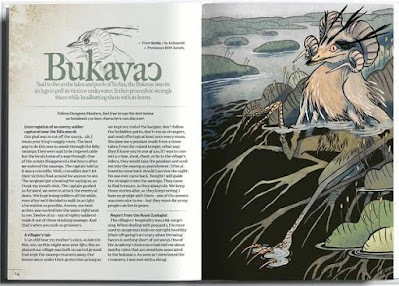REVIEW: A Folklore Bestiary (Volume 1)
 An aspect of Dungeons & Dragons – and, by extension, all fantasy roleplaying games – that I find equally fascinating and frustrating is the way that it adopts and adapts the mythology and folklore of the real world in order to provide fodder for new spells, magic items, and (especially) monsters. I find it fascinating, because of how wide a net Dave Arneson, Gary Gygax, and those followed in their footsteps cast in establishing the canon of D&D. For example, how many of us reading this had ever heard of the tarrasque before seeing it in the pages of the
Monster Manual II
? On the other hand, I find it frustrating, because of how far D&D often deviates from its legendary source material. Again, consider the tarrasque, which bears very little resemblance to its Provençal inspiration.
An aspect of Dungeons & Dragons – and, by extension, all fantasy roleplaying games – that I find equally fascinating and frustrating is the way that it adopts and adapts the mythology and folklore of the real world in order to provide fodder for new spells, magic items, and (especially) monsters. I find it fascinating, because of how wide a net Dave Arneson, Gary Gygax, and those followed in their footsteps cast in establishing the canon of D&D. For example, how many of us reading this had ever heard of the tarrasque before seeing it in the pages of the
Monster Manual II
? On the other hand, I find it frustrating, because of how far D&D often deviates from its legendary source material. Again, consider the tarrasque, which bears very little resemblance to its Provençal inspiration.It's for this reason that I was very excited by the release of A Folklore Bestiary by the Merry Mushmen, perhaps best known for their "adventure gaming bric-a-brac," Knock! "Inspired by folk tales and superstitions," according to its front cover, the Bestiary is a collection of almost forty creatures drawn primarily, but not exclusively, from European legends for use with Old School Essentials and other similar RPGs. With its focus on offering less well-known folkloric monsters as adversaries, allies, and enigmas for fantasy gaming, the Bestiary is a monster book seemingly written with my own peculiar tastes in mind.
With ten different authors credited, no two entries are exactly the same in terms of presentation. In general, though, each entry begins with the creature's name (including a phonetic pronunciation) and place of origin, followed by a short piece of in-setting fiction, like an excerpt from a journal or a transcript of an interrogation. The fiction is largely flavor text, setting the scene for what ordinary people might know or believe about a given creature. After that, there's an Old School Essentials write-up for the monster, sometimes accompanied by random tables useful to the referee, like rumors, motivations, and similar details. All entries also include a collection of adventure hooks involving the creature. Some include full scenarios, featuring a keyed map. Rounding out the entries is a full-page, full-color illustration (and some smaller sketches) by Letty Wilson, whose slightly whimsical artwork some of you might already know from Dolmenwood.
A Folklore Bestiary is a 160-page A5 hardcover that is cleanly and attractively laid out. Compared to, say, Knock!, whose layout some have found cluttered to the point of illegibility at times, the Bestiary is much more conservative, though still distinctive. It's the kind of book that's equally useful as a reference and as reading material that one can flip through for inspiration. This could be off-putting to the more curmudgeonly among old school fans, since there's a lot more in each entry than the monster's game statistics and a basic description of its habitat and behavior. This is a book filled with creatures that live in a larger world and have connections to that world, potentially leading to much more compelling and even meaningful encounters.
Of course, this is also potentially a drawback. Because nearly all of these monsters are drawn from real world mythologies (a standout exception being Lord Dunsany's gnoles), they might not fit into a generic fantasy world as easily. For example, the dybbuk has strong associations with Jewish legends, while Jack-in-Irons is similarly associated with medieval Yorkshire. These associations are a big part of the appeal of the monsters described herein, grounding them in "reality" in a way that is often missing from standard fantasy monsters like goblins, zombies, and even dragons. Yet, they also make it mean that, unless a game is set in the real world, they might need to be stripped of some of their specificity, which could, in turn, genericize them, which would be a shame. Thinking about this now, I can't help but wonder if Gygax and company faced a similar conundrum in creating D&D's well-known menagerie.
Despite that minor point of concern, A Folklore Bestiary is a delightful product, filled with excellent and, above all, unusual new monsters to include in your fantasy roleplaying game campaign. It's also a good reminder that, even a half-century later, there's still plenty of myths and legends that have yet to be tapped for RPGs. Judging by the fact that this book is called "Volume 1," I can only assume that the Merry Mushmen have plans to produce more. If so, I very much look forward to seeing what strange new creatures they'll include.

Published on April 14, 2024 21:00
No comments have been added yet.
James Maliszewski's Blog
- James Maliszewski's profile
- 3 followers
James Maliszewski isn't a Goodreads Author
(yet),
but they
do have a blog,
so here are some recent posts imported from
their feed.



